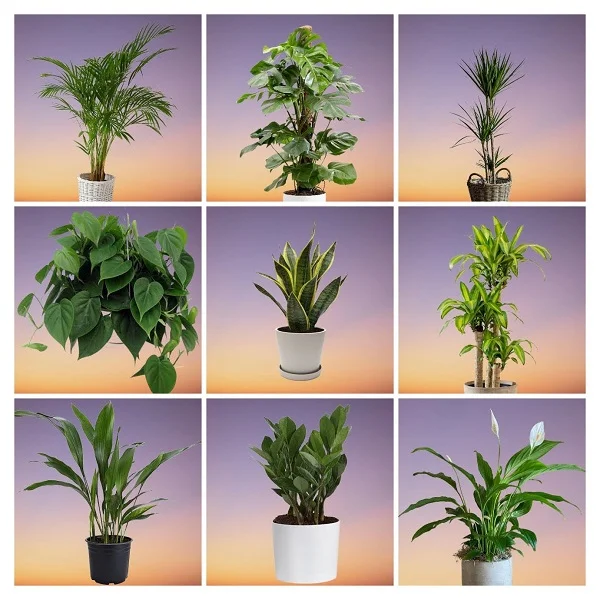18 Low-light Bathroom Plants that Absorb Moisture and Freshen the Air
Some links in this post may be affiliate links
The bathroom is a perfect space for low light plants that love or absorb moisture. The humid, warm and low light conditions existing in the bathroom are ideal for most tropical plants.
Moisture-loving plants absorb moisture through their leaves. This reduces the humidity (moisture) and also freshens up the bathroom.

It is important to avoid overcrowding the bathroom with too many plants. Usually a few plants are adequate for most bathrooms owing to the normal size of a bathroom.
To save on space in the bathroom, plants can be placed on a shelf, a windowsill or in a hanging basket. A floor standing plant is perfect for a large bathroom.
We have herebelow outlined for you 18 of the best low-light plants for the bathroom that absorb moisture to make it easier for you to make your choice.
18 Best Low-light Bathroom Plants
Best low-light bathroom plants that absorb moisture are Anthurium luxurians, Flame Violet, Chinese Evergreen, Song of India, Asplenium Fern, Nerve Plants, Creeping Moss, Earth Stars Bromeliads among others.
1. Anthurium luxurians
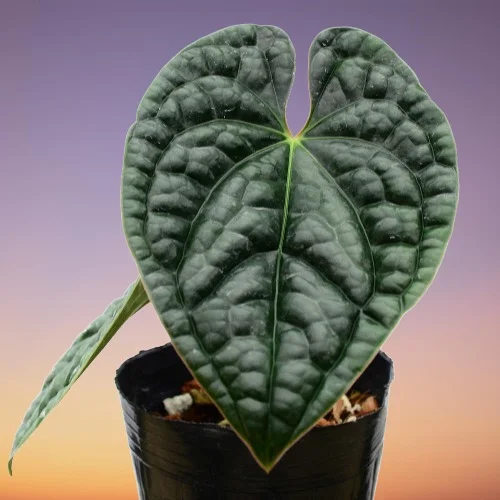
Anthurium luxuriansis one of the popular Anthurium varieties whose large, bullet-shaped leaves are dark-green and have a crinkled leaf surface which reflects light. In the juvenile stage, the foliage is light green and as it matures, it turns dark green to almost black.
The Anthurium luxurians grows to a height of 1-2 feet but the leaves are large and have a spread of about 2 feet. On account of its compact size and affinity for highly warm and humid conditions, Anthurium luxurians and its cousin Anthurium radicans are some of the best plants for the bathroom.
Anthurium luxurians prospers in bright indirect light (dappled light), warmth of 16-270C, humidity of 60-70% and consistently moist, rich, well-drained potting soil coupled with monthly feeding during the growing season.
Read more on how to grow and care for Anthurium luxurians
2. Nerve Plants (Fittonia)
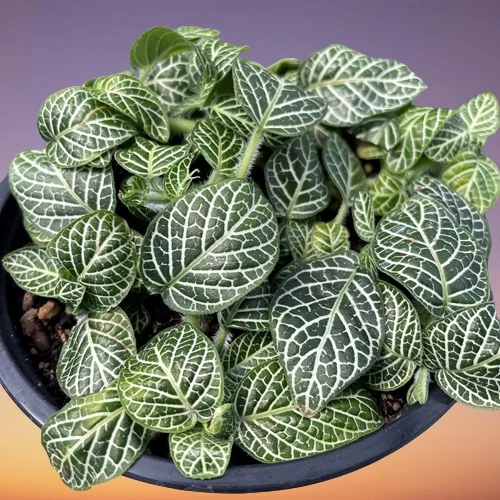
Nerve Plants also called Net plants, Lace leaf or Snakeskin are easily recognisable from their leaves which bear a prominent network of white, pink or red veins.
Fittonia are easy to grow under room conditions when provided with warmth and abundant moisture around the leaves as is common in a bathroom.
Net Plants will flourish in medium to bright indirect light (filtered light), warm and humid conditions and consistently moist, rich, well-drained soil coupled with regular feeding in spring and summer.
Learn more on how to grow and care for Nerve Plants
3. Flame Violet (Episcia cupreata)
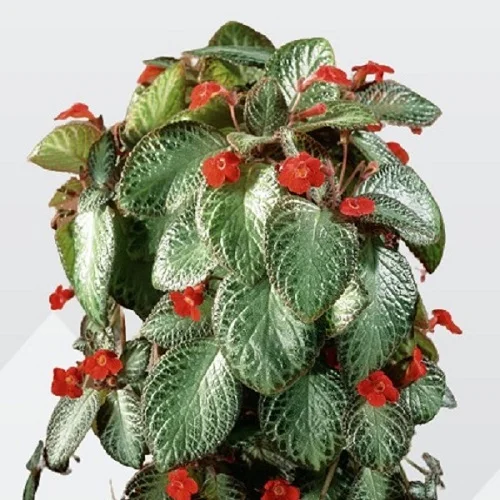
Flame Violet is one of the popular flowering plants on account of its large leaves quilted with silvery or pale-green veins and tubular orange-red flowers which are yellow-eyed and about 3/4 inches in diameter.
Flame Violet may be difficult to grow as a stand alone plant or in a hanging basket. This is due to its requirement for highly humid conditions which places it among the best plants for a bathroom.
Episcia cupreata blooms in bright indirect light, warmth of 15-270C, humidity of 60-70% and consistently moist, rich, well-drained African Violet potting mix coupled with fortnightly feeding in the growing season.
Learn more on how to grow and care for Flame Violet
4. Ficus radicans 'Variegata' (Variegated Rooting Fig)
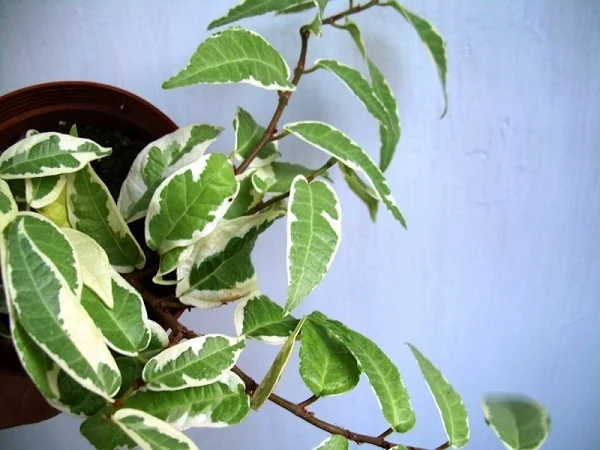
Ficus radicans 'Variegata' is a climbing Ficus plant which bears long, leathery, lance-shaped greyish-green leaves marked with ivory-white edges and long drooping stems.
Being a humidity loving plant, Variegated Rooting Fig can be grown in the humid areas in the home like the bathroom, kitchen and laundry area if the lighting is adequate.
Ficus radicans 'Variegata' flourishes in bright light with 4-6 hours of direct sunlight, warmth of 15-260C, humidity of 60-70%, and moderately moist, rich, well-drained potting soil coupled with fortnightly feeding during the growing season.
Learn more on how to grow and care for Ficus radicans 'Variegata'
5. Song of India Plant (Dracaena reflexa)
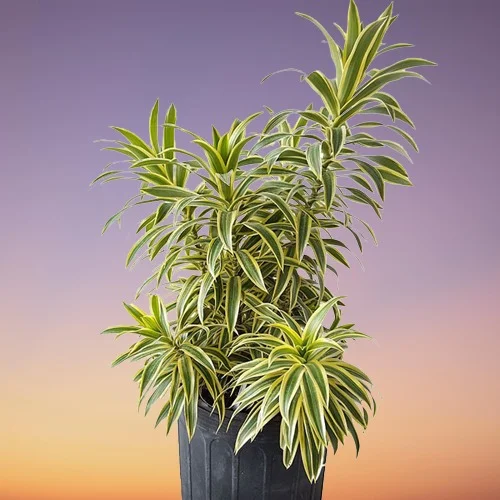
Song of India Plant also called Pleomele or Song of Jamaica is one of the spectacular Dracaena varieties which bears yellow-banded, short, narrow, pointed, green leaves, arranged spirally and are tufted at the end of the branches.
Pleomele is easy to grow and can survive in low light but the variegation develops best under bright light. It requires moist air to thrive which makes it perfect for a well-lit bathroom.
Dracaena reflexa grows best in bright indirect light (dappled light), warmth of 16-270C, humidity of 60-70% and consistently moist, fertile, well-drained soil coupled with fortnightly feeding in the growing season.
6. Bird's Nest Fern (Asplenium nidus)

Bird's Nest Fern or Asplenium Fern is native to the warm, moist, tropical rains forest, therefore the moist humid bathroom conditions are ideal for this plant.
Being a large plant, Bird's Nest Fern can be grown as a focal point plant or in a hanging basket where the long spear-like leaves can hang freely.
Asplenium Fern thrives in bright indirect light, warm and humid conditions, and consistently moist, rich, well drained potting soils coupled with regular feeding in the growing season.
Learn more on how to grow and care for Bird's Nest Fern
7. Chinese Evergreens (Aglaonema)

Chinese Evergreens are easily adaptable to a wide range of growing conditions. Even in poorly lit spots, which is a common feature in most bathrooms, they will easily adapt.
Aglaonemas are also known to be effective in cleaning indoor air of benzene and formaldehyde.
Chinese Evergreens grow best in medium to bright indirect light, warm and humid conditions and moderately moist, rich, well-drained soils coupled with regular feeding in spring and summer.
Learn more on how to grow and care for Chinese Evergreens
8. Creeping Moss (Selaginella)
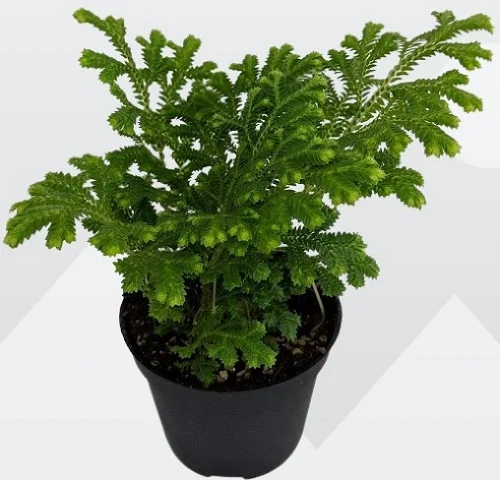
Creeping Moss is an excellent choice for a bathroom. The tiny leaves will shrivel in ordinary room conditions. The warm, moist bathroom conditions mimick the conditions in its natural habitat.
Several varieties of Creeping Moss are available where some are trailing and others bear upright stems upto 1 ft high.
Selaginella prefers bright indirect light, warm and humid conditions and consistently moist, rich, well-drained soils coupled with regular feeding during the growing period.
Learn more on how to grow and care for Creeping Moss
9. Emerald Ripple Peperomia (Peperomia caperata)
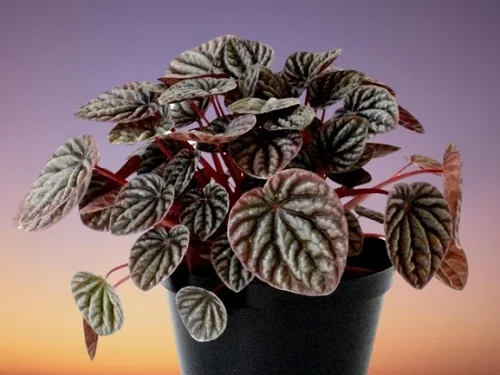
Emerald Ripple Peperomias are some of the popular Peperomia varieties on account of their ease of care and beautifully colored and patterned foliage.
On account of their compact size and love for warm and moist conditions, Peperomia caperata and its relatives Peperomia argyreia (Watermelon Peperomia), Peperomia obtusifolia (Baby Rubber Plant), Peperomia puteolata (Parallel Peperomia) and Peperomia polybotrya (Coin-leaf Peperomia) are among the best plants for the bathroom.
Emerald Ripple Peperomia thrives in average warmth of 15-260C, humidity of 60-70%, medium to bright indirect light and moderately moist, fertile, well-drained potting mix coupled with monthly feeding in the growing season.
Learn more on how to grow and care for Emerald Ripple Peperomia
10. Earth Stars Bromeliads (Cryptanthus Bromeliads)

Cryptanthus Bromeliads are stemless, terrestrial, low-growing, moisture-loving Bromeliad varieties whose small, wavy-edged, colorful leaves make spectacular plants in a bathroom.
Earth Stars are a unique group of Bromeliads in that they only grow terrestrially in soil. Unlike other Bromeliads, Earth Stars root systems are more developed and they do well in well-drained, moisture-holding soils.
Earth Star Bromeliads thrive in bright indirect light, warmth of 18-260C, humidity of 60-70% and moderately moist, fertile, well-drained orchids potting soils coupled with fortnightly feeding in the growing season.
11. Alocasia cuprea (Jewel Alocasia)
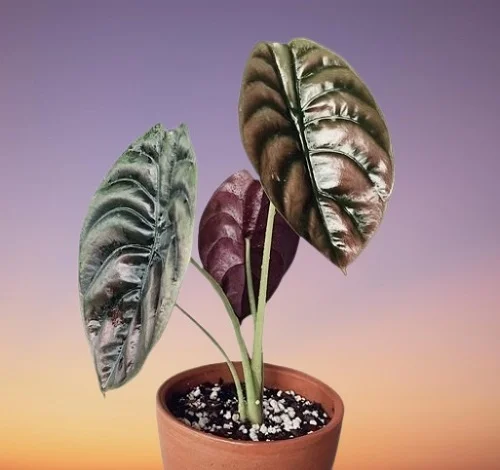
Alocasia cuprea also called Jewel Alocasia is among the compact Alocasia varieties which bears enormous, spherical, green leaves with a metallic gloss, pronounced leaf veins and deep-purple undersides.
Jewel Alocasia and its cousins Alocasia reginula (Alocasia 'Black Velvet') and Alocasia zebrina (Zebra Alocasia Plant) are some of the best plants for a bathroom due to their affinity for warm, humid conditions.
Alocasia cuprea prospers in bright indirect light, warmth of 18-260C, humidity of 70-80% and consistently moist, rich, well-drained soil coupled with fortnightly feeding during the growing season.
Learn more on how to grow and care for Alocasia cuprea
12. Pilea cadierei (Aluminium Plant)

Aluminium Plant or Watermelon Pilea is an evergreen plant which bears dark-green oval leaves, each bearing raised silvery patches and hence the common names.
Pilea cadierei is native to China and Vietnam. The species name "cadierei" is in honour of the 20th century botanist R.P. Cadiere.
Aluminium Plant grows best in bright indirect light, warm and humid conditions and moderately moist, rich, well-drained soil coupled with regular feeding in spring and summer.
Learn more on how to grow and care for Aluminium Plant
13. Calathea warscewiczii (Calathea Jungle Velvet)
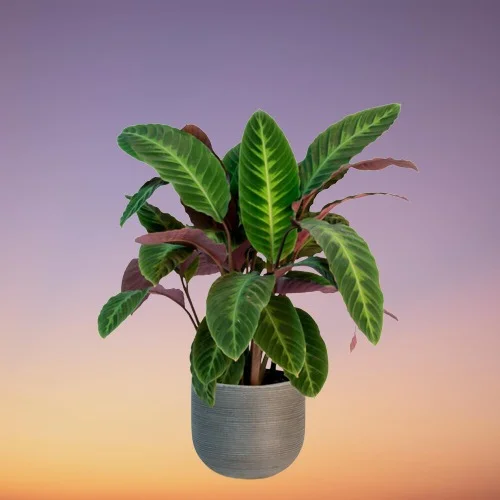
Calathea Jungle Velvet also called Goeppertia warscewiczii is one of the delightful Calathea plants varieties which bears beautifully patterned leaves with purple-toned undersides and a velvety feel.
When given the right growing conditions, Goeppertia warscewiczii as well as its cousins Furry Feather Calathea (Calathea rufibarba), Calathea Freddie (Calathea leopardina) and Calathea picturata (Goeppertia picturata) are gratifying additions to a well-lit bathroom.
Goeppertia warscewiczii blossoms in medium to bright indirect light, warmth of 16-280C, humidity of 60-80% and consistently moist, rich, well-drained soil coupled with monthly feeding during the growing season.
Learn more on how to grow and care for Calathea Jungle Velvet
14. Parlour Palm (Chamaedorea elegans)

Parlour Palm is a popular indoor palm for the poorly-lit spaces, is easy to grow and is ideal for the small (limited) spaces.
Chamaedorea elegans is native to the dense forests of Guatemala and Southern Mexico an environment that is consistently warm and humid.
Parlour Palm has a high tolerance for low light and artificial light. However, it prefers bright indirect light, warm temperatures and rich, well-drained soils coupled with regular feeding in the growing season.
Learn more on how to grow and care for Parlour Palm
15. Baby's Tears Plant (Soleirolia soleirolii)
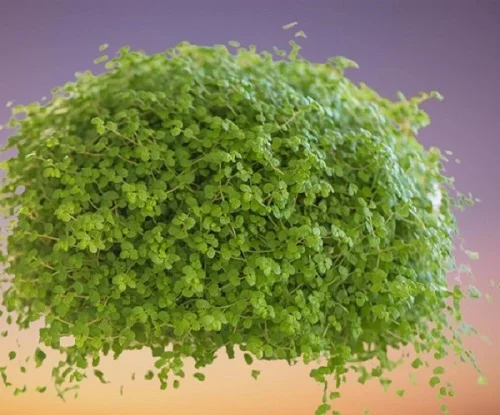
Baby's Tears Plant also called Angel's Tears Plant is among the popular fast-growing plants which bears green or yellow tiny leaves and multitudes of tiny white flowers and is perfect for a hanging basket.
Based on its requirement for high humidity and warm conditions, Angel's Tears Plant is one of the best plants for a bathrom as the atmosphere inside is warm and moist.
Soleirolia soleirolii flourishes in bright indirect light (filtered light), warmth of 15-240C, humidity of 70-80% and consistently moist, well-drained soil that is rich in organic matter coupled with fortnightly feeding during the growing season.
Learn more on how to grow and care for Baby's Tears Plant
16. Maranta (Maranta leuconeura)
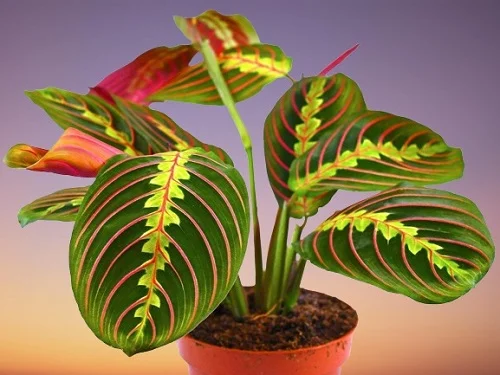
Maranta leuconeura are low-growing plants with long leaves known for their curious habit of folding and raising at night and hence their common name, Prayer Plant.
Maranta are native to tropical Central and South America and the West Indies. They are named for Bartolomeo Maranta, an Italian physician and botanist of the 16th century.
Maranta Plants thrive in partial light, a warm and humid enviroment and consistently moist, fertile, well-drained soil coupled with regular feeding in spring and summer.
Learn more on how to grow and care for Maranta Plants
17. Boston Fern (Nephrolepis exaltata 'Bostoniensis')
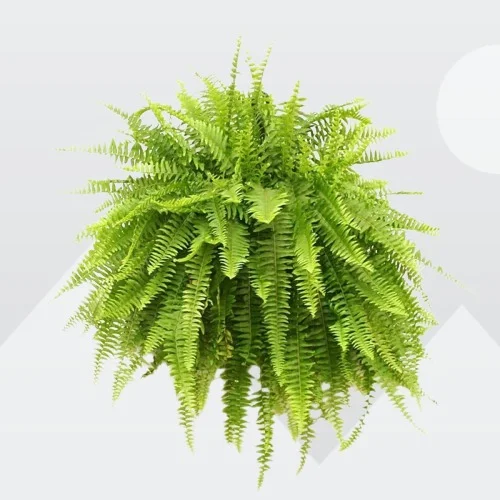
Boston Fern is among the popular fern plants with gracefully arching highly compound, fronds and leaves whose edges appear slightly serrate.
Boston Fern, Davallia canariensis (Hare's Foot Fern) and Davallia fejeensis (Rabbit's Foot Fern) are perfect for the bathroom and can be displayed in a hanging basket, on a pedestal, on a tabletop or anywhere they can be allowed to hang down beautifully.
Nephrolepis exaltata 'Bostoniensis' prospers in bright indirect light, warmth of 15-250C, humidity of 60-70% and consistently moist, fertile, well-drained potting soil coupled with fortnightly feeding during the growing season.
Learn more on how to grow and care for Boston Fern
18. Air Plants (Grey Tillandsia)
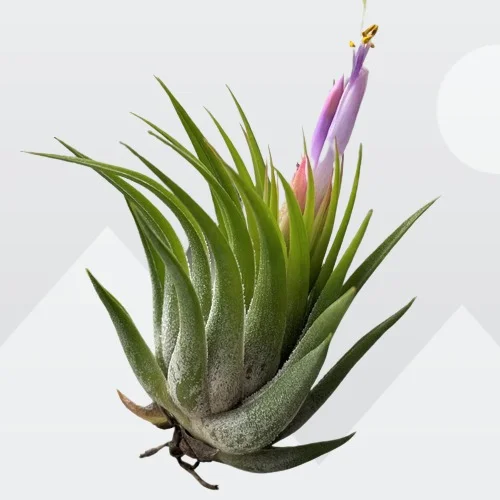
Air Plants are unique plants that do not need to be planted in a potting medium as furry scales on their foliage take up water from humid air and obtain nutrients from air-borne dust and moisture.
Grey Tillandsia literally live on air and hence the common name "Air Plants". These plants can be displayed by sticking them on coral, shells, drift wood, hanging them and many other ways.
Air Plants grow best in bright light but away from direct sunlight, warm and humid conditions coupled with fortnightly feeding during the growing season.
Learn more on how to grow and care for Grey Tillandsia
